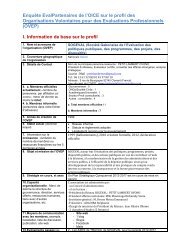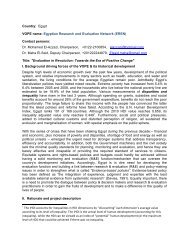10 Sandy Tautworld and exploit it <strong>in</strong> order to further personal or group <strong>in</strong>terests. Values <strong>in</strong>clude ambition,success, and competence. High Harmony cultures accept the world as it is and try to preserve itrather than to change or to exploit it (Berry et al., 1997, Vol. 3, p. 100).Uncerta<strong>in</strong>ty AvoidanceHofstede (1980, p. 110) describes this dimension based on three <strong>in</strong>dicators, “ruleorientation, employment stability and stress level.” In an extension of Hofstede’s research, Bond(1987) found some evidence that underm<strong>in</strong>es the universality of this cultural value (Berry et al.,1997, Vol. 3, p. 99), but at the same time his study replicated Hofstede’s other three dimensions.However, other researchers have cont<strong>in</strong>ued to use the uncerta<strong>in</strong>ty avoidance dimension.Other cross-cultural psychological concepts used here to describe differences betweencultures are:Direct vs. Indirect CommunicationGenerally, direct communication predom<strong>in</strong>ates <strong>in</strong> <strong>in</strong>dividualistic cultures whereascollectivist societies communicate <strong>in</strong>directly (Gudykunst & T<strong>in</strong>g-Toomey, 1988). Selfdisclosure(giv<strong>in</strong>g personal <strong>in</strong>formation to others they don’t know) is associated with directcommunication styles. A crucial variable <strong>in</strong> collectivist cultures is whether communicationoccurs with members of the <strong>in</strong>group or with members of an outgroup; communication will bemore direct (more self-disclosure) among <strong>in</strong>group members compared to communication withoutgroup members. In contrast, there are no differences <strong>in</strong> self-disclosure between <strong>in</strong>group andoutgroup <strong>in</strong> <strong>in</strong>dividualistic cultures (Gudykunst et al., 1992).High-Context vs. Low-ContextClosely related to the above mentioned communication issue is the dist<strong>in</strong>ction betweenhigh-context and low-context cultures. Members of collectivist cultures emphasize theimportance of context <strong>in</strong>formation <strong>in</strong> expla<strong>in</strong><strong>in</strong>g others’ behavior more than people <strong>in</strong><strong>in</strong>dividualistic cultures. This also makes adapt<strong>in</strong>g to the context an important part of highcontextcommunication patterns prevalent <strong>in</strong> collectivist cultures. In addition, Uncerta<strong>in</strong>tyAvoidance (UA, see above) <strong>in</strong>fluences the degree to which communication follows rules andrituals (high UA means highly ritualistic), especially for outgroup communication/<strong>in</strong>teraction.Lastly, Power Distance (PD) also determ<strong>in</strong>es <strong>in</strong>teraction/communication styles; high PD meanslow levels of egalitarian cooperation between people with different amounts of power. S<strong>in</strong>ceoutgroup members are outsiders, they tend to have less power than <strong>in</strong>siders (see Berry et al.,1997, Vol. 3, p. 142).
Cross-Cultural Transferability of the <strong>Program</strong> <strong>Evaluation</strong> <strong>Standards</strong> 11Seniority‘Seniority’ generally refers to the level of one’s social stand<strong>in</strong>g based on one’s age. Incross-cultural organizational psychology, the concept of ‘seniority’ is commonly used todescribe promotion systems. In contrast to <strong>in</strong>dividualistic societies, organizations <strong>in</strong> collectivistcultures base promotion on employees’ loyalty, seniority, and <strong>in</strong>-group membership (Berry et al.,1997, Vol. 3, p. 379).F<strong>in</strong>ally, one needs to address the fact that cultures are constantly chang<strong>in</strong>g over time.<strong>The</strong>re are two ways <strong>in</strong> which cultural change comes about: <strong>in</strong>novation (<strong>in</strong>ternally generatedchange) and diffusion (adopt<strong>in</strong>g traits from another society). People are receptive of new traitswhen these enhance their economic and social well-be<strong>in</strong>g. In addition, political and economicdom<strong>in</strong>ation, as well as environmental and demographic changes can all <strong>in</strong>troduce culturalchanges (see Peoples & Bailey, 1995, p. 105). In an <strong>in</strong>creas<strong>in</strong>gly <strong>in</strong>terdependent world (with aglobal economy, immigration flows and world-wide communication), cultural change will likelyhappen more quickly. S<strong>in</strong>ce values are reflective of cultural changes, it is also likely that therewill be value changes <strong>in</strong> the form of adaptations to the chang<strong>in</strong>g environment. Yet, every culturalsett<strong>in</strong>g is unique, thus mak<strong>in</strong>g values a cont<strong>in</strong>uously valid way to differentiate cultures (Berry etal., 1997, Vol. 3, p. 110).<strong>The</strong> Role of Professional <strong>Standards</strong> Across Cultures<strong>The</strong> concept of professionalism <strong>in</strong> evaluation differs across cultures. As one componentof this concept, professional standards for enhanc<strong>in</strong>g the quality of evaluators’ performance areof vary<strong>in</strong>g importance <strong>in</strong> different societies. Smith et al. (1993) compare Malta, India and theUnited States along these l<strong>in</strong>es. In the U.S., professional groups historically regulate themselvesthrough professional standards and compliance with self-generated laws and pr<strong>in</strong>ciples has longexisted. In contrast, “[…]<strong>in</strong> Malta and India, the quality of one’s evaluation work is more likelyto be judged on political than on technical or professional grounds. Professional standards wouldplay a much weaker role <strong>in</strong> regulat<strong>in</strong>g evaluation practice […]” (p. 8). <strong>The</strong> authors conclude that“the development and use of <strong>in</strong>digenous professional standards are unlikely, unwelcome, andprobably unuseful” (p. 9). In contrast, for example, Widmer (1999) observes for the Swisscontext that the set of <strong>Standards</strong> proposed by the Swiss <strong>Evaluation</strong> Society (SEVAL) are usedmore and more as part of regulations, manuals, contracts, and decrees. He posits that, <strong>in</strong> theGerman-speak<strong>in</strong>g countries, the <strong>Standards</strong> serve as a means to build a “professionell orientiertesSelbstverstndnis [professionally oriented self-perception]” with<strong>in</strong> the evaluation community (p.8). Beywl (1999) theorizes that the <strong>Standards</strong> will <strong>in</strong>fluence the field of evaluation <strong>in</strong> Germanyalmost from its birth while <strong>in</strong> the U.S. the development of the <strong>Standards</strong> marked the arrival of acerta<strong>in</strong> level of maturity of the field. He advises the German <strong>Evaluation</strong> Society (DeGEval) toendorse an adapted version of the <strong>Standards</strong> as pr<strong>in</strong>ciples for proper conduct. Likewise, Russon& Patel (1999) report from a focus group discussion on the <strong>Program</strong> <strong>Evaluation</strong> <strong>Standards</strong> thatthe n<strong>in</strong>e participat<strong>in</strong>g African evaluators “reached a rapid consensus that there was a need forsome set of criteria of quality” <strong>in</strong> Africa (p. 4).
- Page 1 and 2: The Program Evaluation Standardsin
- Page 3 and 4: The editor acknowledges the valuabl
- Page 5 and 6: ForewordOn February 18-20, 2000, th
- Page 7 and 8: Hopefully, this volume will contrib
- Page 9 and 10: 5Cross-Cultural Transferabilityof T
- Page 11 and 12: Cross-Cultural Transferability of t
- Page 13: Cross-Cultural Transferability of t
- Page 17 and 18: Cross-Cultural Transferability of t
- Page 19 and 20: Cross-Cultural Transferability of t
- Page 21 and 22: Cross-Cultural Transferability of t
- Page 23 and 24: Cross-Cultural Transferability of t
- Page 25 and 26: Cross-Cultural Transferability of t
- Page 27 and 28: Cross-Cultural Transferability of t
- Page 29 and 30: Cross-Cultural Transferability of t
- Page 31: Cross-Cultural Transferability of t
- Page 34 and 35: 30 Nick L. Smith, Saviour Chircop a
- Page 36 and 37: 32 Nick L. Smith, Saviour Chircop a
- Page 38 and 39: 34 Nick L. Smith, Saviour Chircop a
- Page 40 and 41: 36 Nick L. Smith, Saviour Chircop a
- Page 42 and 43: 38 Nick L. Smith, Saviour Chircop a
- Page 44 and 45: 40 Nick L. Smith, Saviour Chircop a
- Page 46 and 47: 42 Soojung Jangyears. Due to the sc
- Page 48 and 49: 44 Soojung JangThis test-based sele
- Page 50 and 51: 46 Soojung JangTable 1. Descriptive
- Page 52 and 53: 48 Soojung JangU2 Evaluator Credibi
- Page 54 and 55: 50 Soojung Janggenerous to foreigne
- Page 56 and 57: 52 Soojung Jangfeelings. This partl
- Page 58 and 59: 54 Soojung JangReporting Informatio
- Page 60 and 61: 56 Soojung JangU4 Values Identifica
- Page 62 and 63: 58 Soojung JangReferencesBecker, C.
- Page 64 and 65:
60Standards for Evaluation:On the W
- Page 66 and 67:
62 Wolfgang BeywlThe advantage of t
- Page 68 and 69:
64 Wolfgang BeywlA more direct way
- Page 71 and 72:
67Evaluating Evaluations: Does the
- Page 73 and 74:
Evaluating Evaluations 69Bussmann 1
- Page 75 and 76:
Evaluating Evaluations 71• Housin
- Page 77 and 78:
Evaluating Evaluations 73Table 1: C
- Page 79 and 80:
Evaluating Evaluations 75• Contra
- Page 81 and 82:
Evaluating Evaluations 77References
- Page 83 and 84:
Evaluating Evaluations 79Raven, J.
- Page 85 and 86:
81Evaluation StandardsRecommended b
- Page 87 and 88:
Evaluation Standard Recommended by
- Page 89 and 90:
Evaluation Standard Recommended by
- Page 91 and 92:
Evaluation Standard Recommended by
- Page 93 and 94:
Evaluation Standard Recommended by
- Page 95 and 96:
Evaluation Standard Recommended by
- Page 97 and 98:
Evaluation Standard Recommended by
- Page 99 and 100:
Evaluation Standard Recommended by
- Page 101 and 102:
Evaluation Standard Recommended by
- Page 103 and 104:
Evaluation Standard Recommended by
- Page 105 and 106:
Evaluation Standard Recommended by
- Page 107 and 108:
103AnnexThe complete list of the or
- Page 109:
Annex 105A4 Defensible Information






